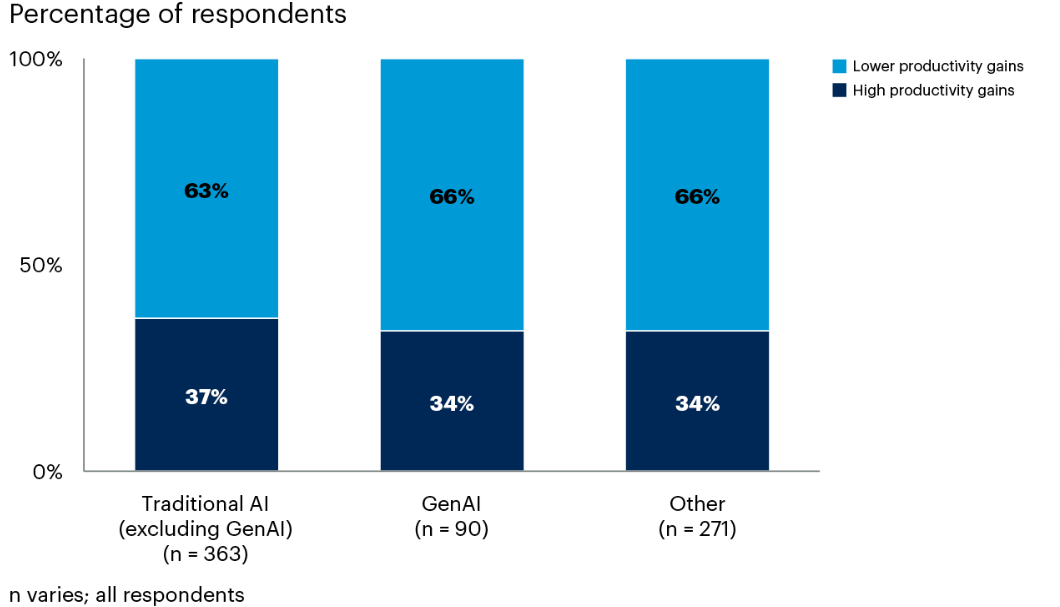Gartner Advises CFOs to Adjust Expectations Regarding AI’s Effects on Workforce Productivity and Staffing

Challenges of AI in Boosting Productivity
Despite the potential of artificial intelligence (AI) to improve efficiency, many organizations face difficulties in achieving significant productivity gains from their investments in both traditional AI and generative AI. A recent survey conducted by Gartner, Inc. highlights these challenges, revealing gaps between expected and actual productivity improvements.
Survey Insights
The Gartner survey engaged 724 participants spanning various business functions from June to August 2024. It found that 37% of teams utilizing traditional AI reported high productivity gains, while teams leveraging generative AI fared slightly lower, with a 34% success rate. These findings underscore a mixed performance regarding AI’s efficacy in the workplace.
Randeep Rathindran, a Distinguished Vice President at Gartner, discussed these findings during the Gartner CFO & Finance Executive Conference held in March 2025. He pointed out a phenomenon known as the "AI productivity paradox," where despite the excitement around AI, achieving consistent productivity gains remains elusive. While certain sectors, like call centers, have experienced significant benefits, broader organizational productivity has not seen the same level of improvement.
Factors Affecting Productivity Gains
Several elements can limit the productive impact of AI in organizations:
Inflated Expectations: Many businesses have high hopes for what AI can achieve, often overlooking its limitations. While AI excels at automating tasks and providing insights, this doesn’t always translate to widespread productivity improvements.
Measurement Challenges: Assessing productivity gains from AI can be complex. Inconsistent metrics can make it difficult to gauge the true value AI brings to an organization.
Implementation Delays: Typically, organizations face lagging implementation timelines, which can postpone the realization of AI’s benefits.
- Uneven Distribution of Gains: The productivity dividends of AI are not evenly distributed across different functions. Marketing departments often report significant benefits from AI, while sectors like legal and human resources lag behind.
Leveraging AI Effectively
To maximize the benefits of AI, teams need to adopt a mindset open to learning and experimenting with new uses of the technology. Rathindran emphasizes the importance of restructuring workflows to eliminate inefficiencies and redirect focus toward value-added tasks. This approach can significantly enhance the productivity gains achieved through AI.
Rethinking Expectations
Business leaders, including CFOs, should temper their initial expectations regarding AI’s impact. Instead of viewing AI as a one-size-fits-all solution for efficiency, organizations should create a conducive internal environment that enables AI to reach its full potential. This shift entails challenging preconceptions about cost savings and workforce reductions associated with AI technologies.
Strategic Approaches to Implementing AI
Organizations can enhance their chances of harnessing AI’s productivity benefits by:
Encouraging a Collaborative Culture: Fostering teamwork and openness can promote a culture where AI is seen as a tool for enhancement rather than a threat to jobs.
Adopting a Structured Exploration: Businesses should focus on systematic experimentation with AI solutions to identify effective use cases.
- Educating Leadership: Equipping C-suite executives and finance leaders with knowledge about organizational behaviors that influence AI performance is key to harnessing its potential.
As both traditional and generative AI continue to evolve, organizations must align their expectations with the current realities of AI’s capabilities. By understanding the nuances of AI’s impact and encouraging a culture of continuous learning and acceptance, companies can tap into AI’s potential for sustainable success.
For further details, Gartner clients can access the study titled AI’s Impact on Productivity and Headcount. Non-clients may refer to The CFO Report for more insights.





